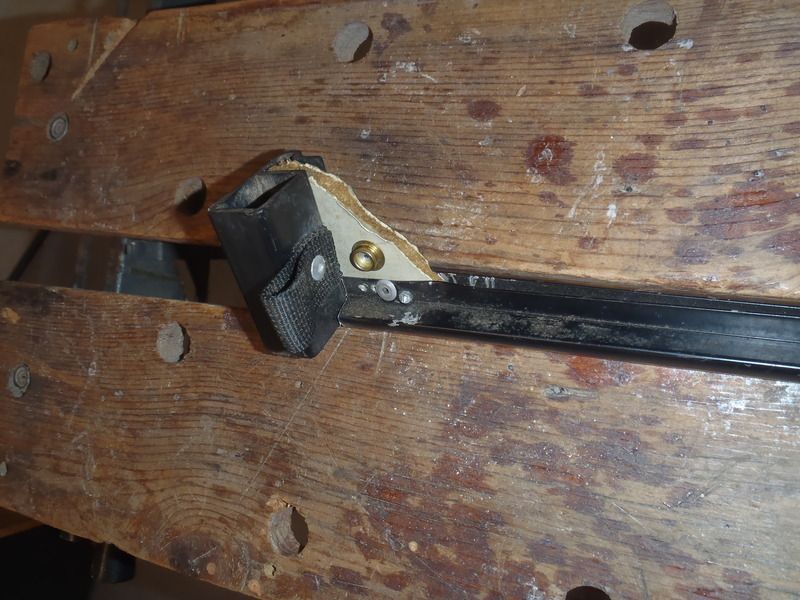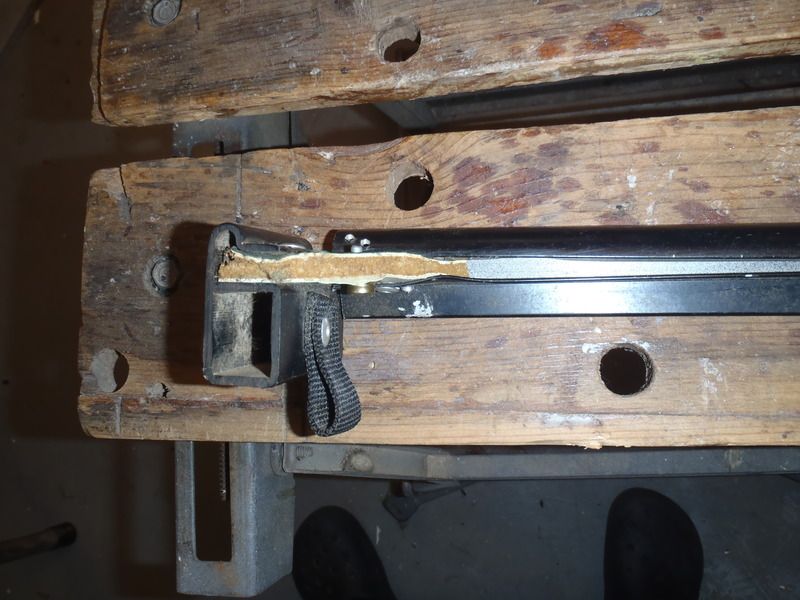Without an interesting boat project in the shop I am vicariously enjoying Doug’s Rob Roy re-gunwaling.
Some months ago Doug generously offered me first dibs on the Rob Roy when he found it, but that was back when it had (albeit poorly installed) gunwales and could actually be paddled.
In a humanitarian gesture I have offered him half what he paid and a case of Yuengling for the now gunwale-less Rob Roy remains, wishing only to spare him any further trials and travails. It simply pains my heart to see a fellow boat tinkerer suffer so.
I think aluminum gunwales are going to work. And I’m starting to like the simplicity of the Wenonah one piece gunwales, exposed rivet shanks be danged.
Aluminum gunwales will need a couple or four of those thwart end L clips, two for the thwart behind the seat and maybe two for a short carry thwart up front.
What to do with the aluminum gunwale transition at the bow and stern ends of the Rob Roy might get a little tricky
https://www.google.com/search?q=Bel...=RCDXVveSDcXimAHgzr64Bg#imgrc=otpd33hoCVyPMM:
On the front an inset deck plate is going to be dang near impossible, and a top mounted wood deck plate will rest poorly unless some curved reveal is routed out on the bottom, so the deck plate nestles on the curved top of the gunwales. In any fashion that would provide the perfect crevices to accumulate dirt and debris wood rot in an otherwise maintenance-free aluminum gunwale rebuild.
And, honestly, a wood deck plate on aluminum gunwales is just gonna look weird.
The easiest solution would be to find one of those winky (and near weightless) Wenonah end caps that approximates the bow gunwale angle of the Rob Roy, and simply pop rivet it in place, just like Wenonah does. That would happily eliminate any need to custom cut the ends of the gunwales so they fit precisely flush-angled /\ together below a top mounted deck plate.
I just poked my fingers in and checked, the ends of the aluminum gunwales on the Wenonah Wilderness are simply cut straight, and end a good three or four inches shy of the stem. Who cares, that little black plastic end cap hides all and looks nice. Easy peezy simple. Good enough for Wenonah, good enough for me.
https://www.google.com/search?q=Wen...ei=mCjXVrivGsnre9ferMgM#imgrc=5tHNh-PNXHKV6M:
When an end cap (or even a big plastic deck plate) has not been a perfect match I have slowly heated them up under a halogen lamp and used a heat gun, making them pliable enough bend inwards to a narrower fit, leaving a bit of arch atop. Once heated and bent they retain that shape.
Using Wenonah gunwales and a Wenonah end cap would guarantee that the profile of the outwale lip fits the profile of the cap.
Using an end cap would necessitate adding a bow carry thwart (via L brackets), but a carry thwart would be a good thing. I don’t especially like hauling or lifting boats via deck plates, and certainly not grabbing end caps. Plus a bow carry thwart would provide a handy place to store the painter line under a wider lateral run of bungee.
To estimate end cap sizing I’d try sliding a couple of short pieces of excess aluminum gunwale up at the bow end and measure/trace the angle of the deck cap needed. Just for funsies the deck cap on my Wenonah Wilderness is 7 ½ inches long by 5 ½ inches wide, outside edge to outside edge. I’d wager that Wenonah makes a narrower version for their longer, skinner hulls.
What to do with the transition of the aluminum gunwales at the back end of the cockpit is trickier. I believe that the OEM wood inwales slipped into slots in that odd (non-functionally designed – Doug knows what I mean) molded back “deck”, and the outwales just abruptly terminated thereabouts on the sides near the back deck.
https://www.google.com/search?q=Bel...=RCDXVveSDcXimAHgzr64Bg#imgrc=8yY66lxJ5qtyLM:
I would probably want to plug that inwale slot in the back deck, and would certainly not want to have the cut-aluminum gunwale ends nakedly exposed on the outside of the hull to rip my flesh in an out-of boat-experience or when walking alongside the boat in camp.
That would be the place for a couple of short, custom shaped wood gunwale sections. A short length of inwale, matching the profile of that slot to fill the hole and an outer piece matching the profile of aluminum gunwale outwale, screwed together in the traditional wood gunwale manner.
Hell, if the outwale profile custom matches the black anodized aluminum maybe paint the wood black for a more seamless transition. The wood outwale piece would also provide an extended length lip to capture a spray skirt rand as well.
dang Doug, that seems like an awful lot of work, and we haven’t even gotten to improving the seat.
https://www.google.com/search?q=Bel...ei=uzHXVrW3OIu4ec2NvugK#imgrc=7DTKM3yg71-0-M:
Final offer. $400 and a case of Bud Lite, but you have to deliver the boat to Maryland.









